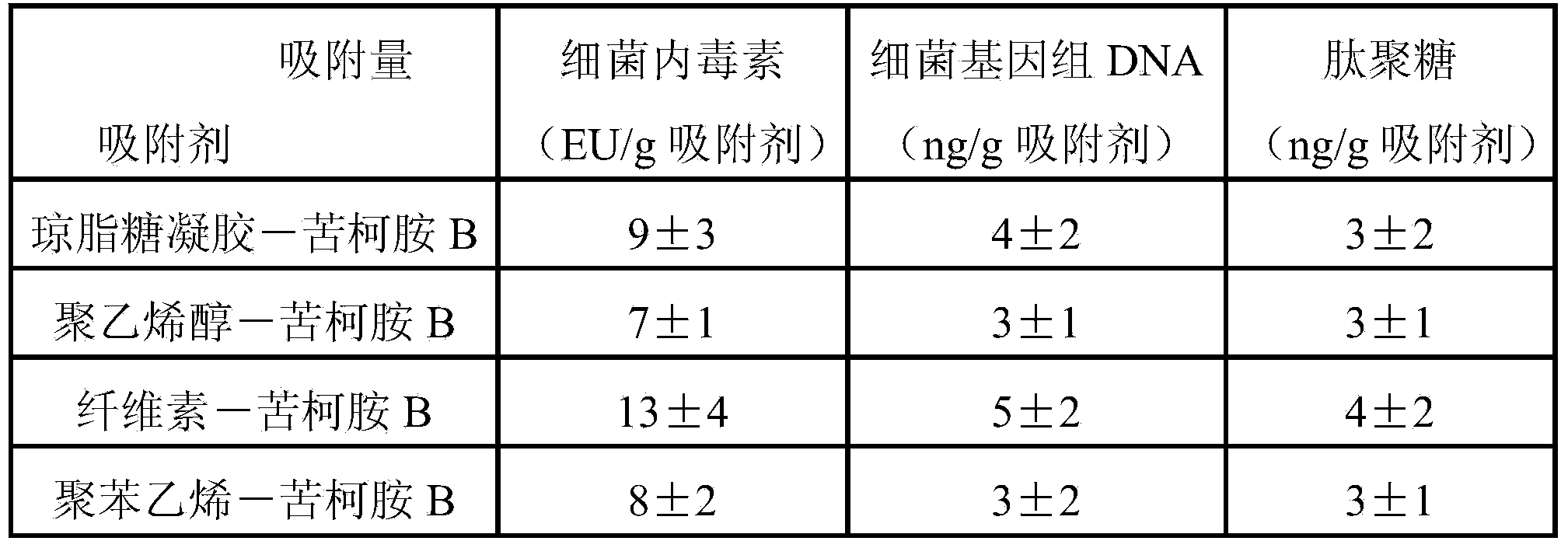Adsorbent for removing bacterial endotoxin, DNA and peptidoglycan and preparation method and use
A technology of bacterial endotoxin and adsorbent, which is applied in the field of medicine, can solve the problem that the adsorbent can only adsorb bacterial endotoxin, etc., and achieve the effect of good adsorption effect and good adsorbent
- Summary
- Abstract
- Description
- Claims
- Application Information
AI Technical Summary
Problems solved by technology
Method used
Image
Examples
Embodiment 1
[0033] Example 1: Preparation of agarose gel-picrylamine B adsorbent
[0034] 1.1 Experimental method: Sepharose CL-4B was used for the agarose gel, purchased from GE Healthcare. Take 20ml of Sepharose CL-4B agarose gel, wash with ultrapure water, and filter to dryness. Take 4g of the dried gel, add 10ml of 0.5M NaOH solution and 10ml of epichlorohydrin, and shake at 40°C for 5 hours. After the reaction was completed, it was washed with ultrapure water and filtered to dryness. Take 100mg Kuchrysamine B, dissolve in 50ml0.1M NaHCO 3In the solution, it was mixed with agarose gel activated by epichlorohydrin, and reacted with shaking at 25°C for 24 hours. After the reaction is completed, wash with ultrapure water, and suction filter to dryness (all the filtrate is collected) to obtain Sepharose-Crysamine B adsorbent. For the collected filtrate, use high performance liquid chromatography (chromatographic column: octadecylsilane bonded silica gel as filler; mobile phase: 0.1% t...
Embodiment 2
[0038] Example 2: Preparation of polyvinyl alcohol-picrylamine B adsorbent
[0039] 2.1 Experimental method: The preparation principle of polyvinyl alcohol-picrylamine B adsorbent is similar to that of agarose gel-picrylchryl B adsorbent. Polyvinyl alcohol was purchased from Sigma-Aldrich. Dissolve 5g of polyvinyl alcohol in ultrapure water to make a 10% aqueous solution, put it in a constant temperature water bath at 90°C and stir until completely dissolved, then freeze at -20°C for 24 hours, take it out and thaw at room temperature for 4 hours, Freezing and thawing were repeated three times in this way to obtain polyvinyl alcohol hydrogel. Suction filter the gel to dryness, take 4g of the gel, add 10ml of 0.5M NaOH solution, 10ml of epichlorohydrin, shake and react at 50°C for 5 hours. After the reaction was completed, it was washed with ultrapure water and filtered to dryness. Take 100mg Kuchrysamine B, dissolve in 50ml0.1M NaHCO 3 In the solution, it was mixed with pol...
Embodiment 3
[0041] Embodiment 3: Preparation of cellulose-picrylamine B adsorbent
[0042] 3.1 Experimental method: The preparation principle of the cellulose-picrylamine B adsorbent is similar to that of the agarose gel-picrylchryl B adsorbent. Cellulose was purchased from Sigma-Aldrich. Take 5g of cellulose, add 10ml of 0.5M NaOH solution, 10ml of epichlorohydrin, and shake at 40°C for 4 hours. After the reaction was completed, it was washed with ultrapure water and suction filtered to dryness. Take 200mg Kuchrysamine B, dissolve in 100ml 0.1M NaHCO 3 In the solution, mix with the cellulose activated by epichlorohydrin, shake and react at 25°C for 24 hours. After the reaction is completed, wash with ultra-pure water and suction filter to dryness to obtain cellulose-picrylamine B adsorbent. The calculation method of the immobilization capacity of Kuchrysamine B is the same as in Example 1.
[0043] 3.2 Experimental results: After detection and calculation, the immobilization capacit...
PUM
| Property | Measurement | Unit |
|---|---|---|
| Loading capacity | aaaaa | aaaaa |
Abstract
Description
Claims
Application Information
 Login to View More
Login to View More - R&D
- Intellectual Property
- Life Sciences
- Materials
- Tech Scout
- Unparalleled Data Quality
- Higher Quality Content
- 60% Fewer Hallucinations
Browse by: Latest US Patents, China's latest patents, Technical Efficacy Thesaurus, Application Domain, Technology Topic, Popular Technical Reports.
© 2025 PatSnap. All rights reserved.Legal|Privacy policy|Modern Slavery Act Transparency Statement|Sitemap|About US| Contact US: help@patsnap.com


